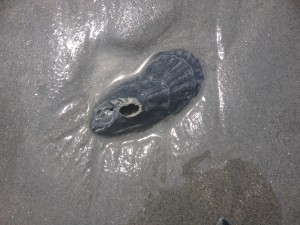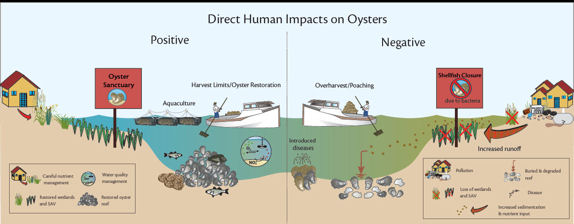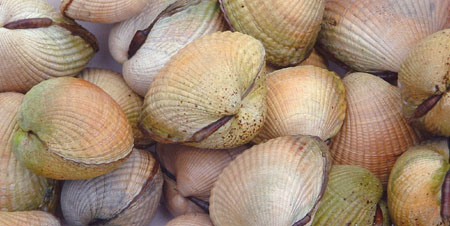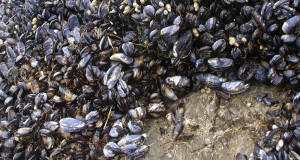O-Y-S-T-E-R! Happy National Oyster Day! There needs to be much love for the oyster. These creatures are delicious, sustainable, and help the environment. Maybe we need more than just one day to celebrate this bivalve? If you don’t believe me, here are over 20 reasons oysters are awesome:
- Oysters spawn during the summer months and therefore tend not to be as tasty. This is the epitome of the old wives’ tale on why “you shouldn’t eat oysters in months that don’t end in ‘R’.”
- Another reason this adage has prevailed is that oysters are much better when cold and do not taste that good when in the heat.
- Oysters can change their sex. They can produce both semen and eggs.
- Oysters have been known to live up to twenty years in captivity.
- When oyster larvae attach to a hard material, a vital part of their life cycle, they’re called “spat.” Two to three years later they are considered adults.
- The habitat of the Eastern American oyster (Crassostrea virginica) extend from Canada to Argentina.
- Even though there are countless (and delicious) varieties of oysters there are only five species. These species are the Pacific oyster (Crassostrea gigas), Kumamoto oyster, European flat oyster, American (i.e., Eastern) oyster, and the Olympia oyster. The shells of the five species are truly what sets these species apart (other than the geographic region they are most often found). The American is pretty familiar with its large size and comma shaped shell. The Olympians have a small, round, pale shell with lustrous coloring. The Kumamotos have a round, pale shell as well but not as much of a smooth shell. The European flat has fine ridges around its large, straight shell, and the Pacific are small with wavy shells. In fact, the same type of oyster can taste different contingent on where it was raised.

- Sometimes a bacteria that commonly grows along coastal environments where oysters are found known as Vibrio vulnificus can infect the oysters. This would leave to that “bad oyster” that might make you sick.
- One very common misunderstanding of the oyster is that they are an aphrodisiac. However, it’s really just their significant amount of zinc. Zinc is a mineral that will boost your energy and therefore can boost your sex drive. Other benefits of zinc are that skin will improve and make your bones stronger.
- Oysters also have immense amounts of omega-3-fatty acids which can sharpen your memory, lower levels of depression and heart disease, as well as a host of other benefits.
- Oysters also have lots of vitamin A, C, D and B-12.
- Even though Boticelli’s “The Birth of Venus” has Aphrodite rising from the sea on a scallop shell legend has it that the Goddess of Love, Aphrodite, emerged from the sea in an oyster shell.
- In the 17th century, New York City was covered in oyster beds and were very much enjoyed by the native Lenape Indians. Eventually, by the 19th century, the oysters were so plentiful that raw oysters could be purchased from the street vendors. There was even oyster saloons with all sorts of methods for consuming oysters.
- Most pearls found in jewelry are from clams and mussels – not oysters. Although, there are also actual pearl oysters which are from a different family of bivalves.
- Oyster mushrooms and black salsify, also called “vegetable oyster”, actually taste like oysters.
- Oysters are a crucial member to the aquatic communities. Not only do they gobble up lots of algae (think of your back bay becoming a dirty fish tank without them), but they are crucial as natural filter feeders. Oysters filter approximately 30 to 50 gallons of water a day removing excess nutrients and allowing shrimp, clams, crabs, and snails to flourish. The cleaner water also enables more seagrass to grow creating more habitat for fish.
- Oysters grow on top of one another as an oyster reef. These huge substrates are imperative for soil erosion and shoreline stabilization.

- If you bring home oysters for your next bake be sure to recycle the shells close to home. The shells of the oysters are extremely rich in calcium and can help balance the pH of the soil as well as add nutrients to your garden. Fertilizer fresh from the sea!
- Oyster farms, unlike other types of fish farming, can greatly enhance the health of nearby waterways. Not only do they tend to munch on pollution (yes, they’ve been known to help out Big Oil), but if the oyster were to escape it isn’t in danger of becoming an exotic species.
- While it’s all well and good that farmed oysters can do a lot to help water quality … natural oysters reefs are just as vital. Unfortunately, 85% of the global oyster reef population has been lost.
- In the Chesapeake Bay an estimated 2,600 acres of oyster beds are lost each year because of runoff and silt. On the Pacific coast invasive crabs and snails are destroying natural oyster beds.
- Not only are oyster reefs vanishing, but the ones that remain are just not as strong due to ocean acidification (i.e., climate change for the sea).
- There are many organizations along the Atlantic coast that are looking for volunteers to help adopt and raise oysters. If you don’t live on the water volunteers are still urged to build oyster reef substrates or oysters mats.
Resources: Food Republic, NOAA – Cheasapeake Bay Office, Organic Life, Oyster Recovery Partnership.

















What people are saying …